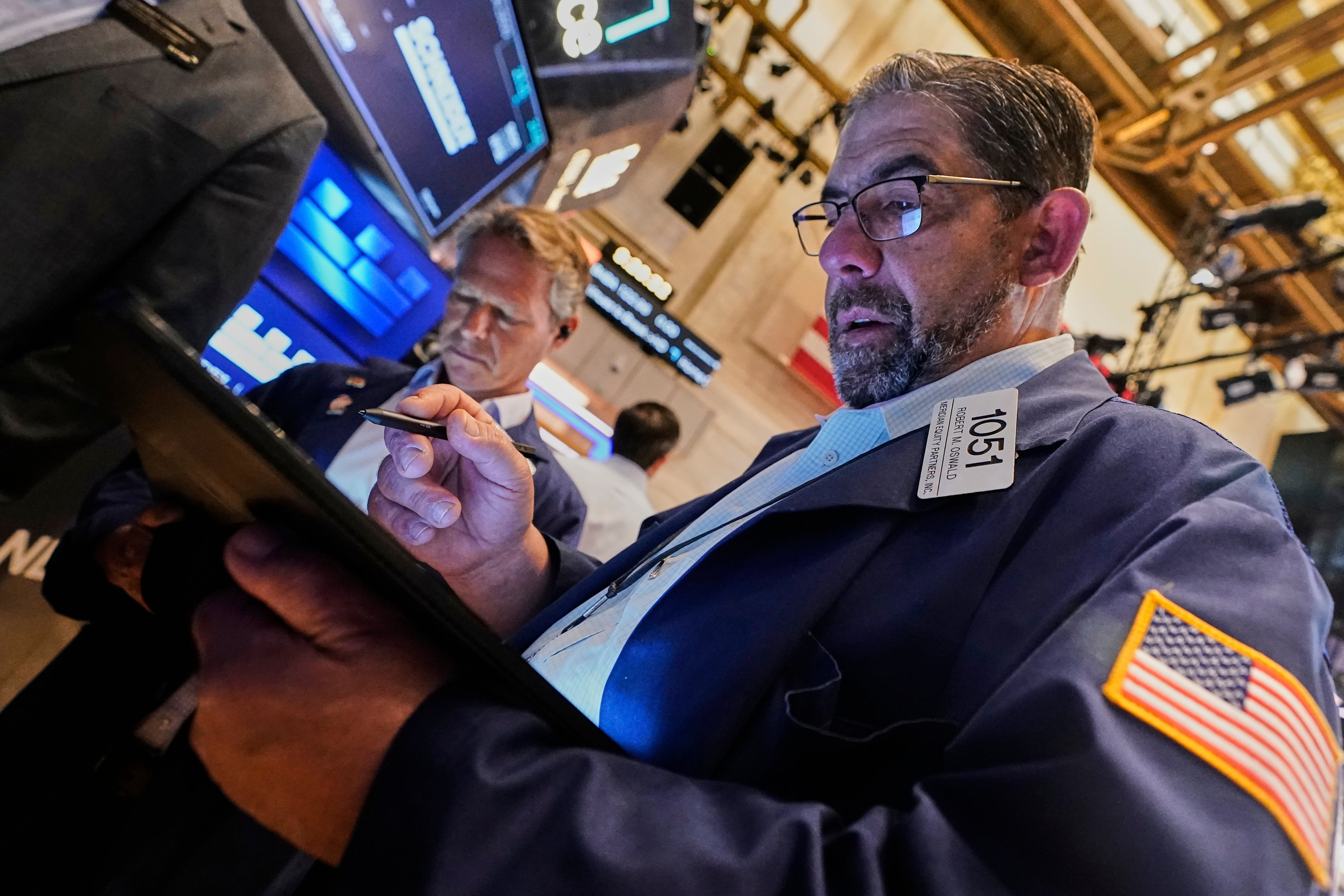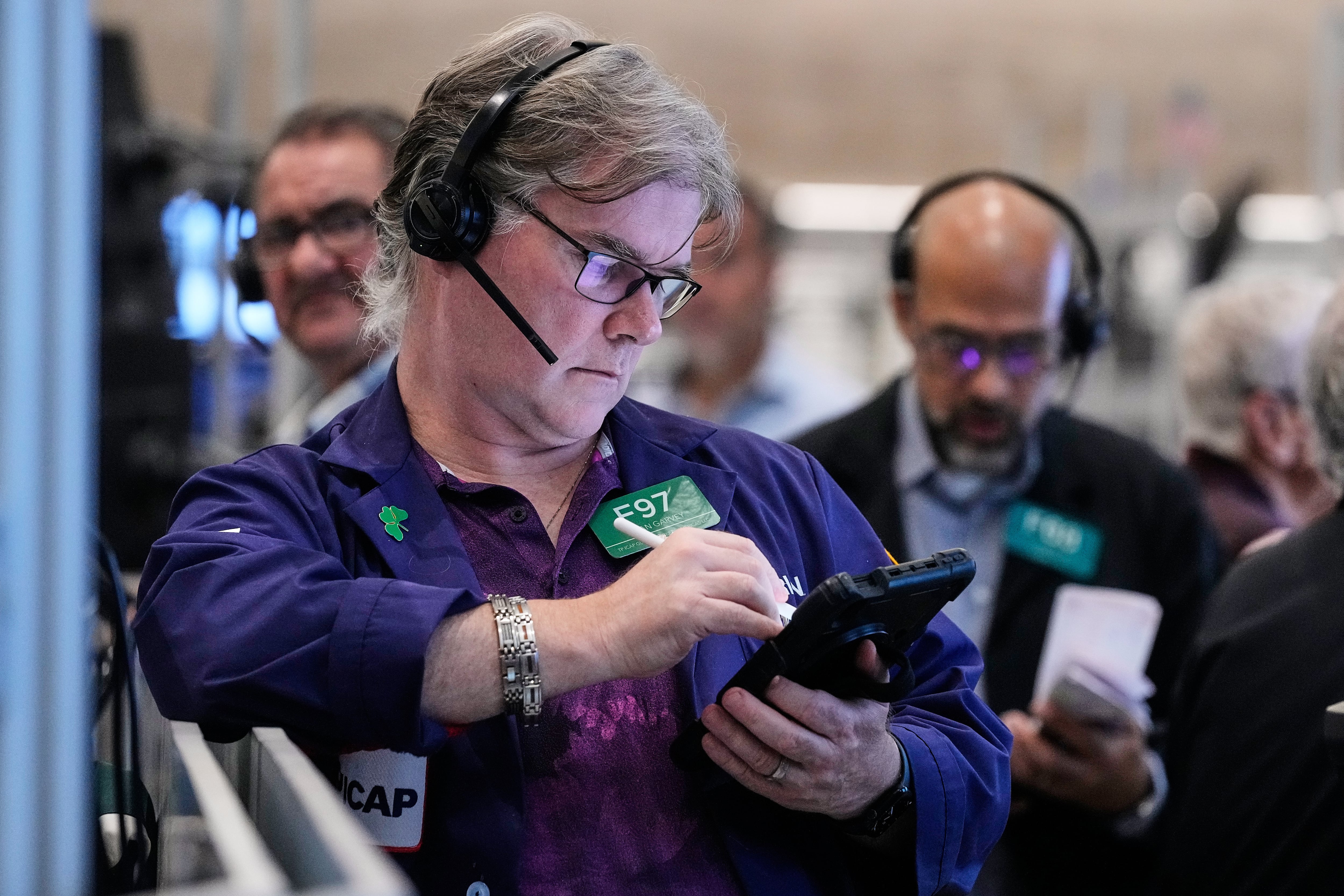NEW YORK (AP) — U.S. stocks are falling on Friday after President Donald Trump threatened 50% tariffs on the European Union that could begin in a little more than a week.
The S&P 500 was down 0.4% in afternoon trading and on track for its worst week in the last seven. The Dow Jones Industrial Average was down 132 points, or 0.3%, as of 1:58 p.m. Eastern time, and the Nasdaq composite was 0.6% lower.
Trump threatened the tariffs before the U.S. stock market opened, saying on his Truth Social platform that trade talks with the European Union “were going nowhere” and that “straight 50%” tariffs could go into effect on June 1. The European Union is one of the United States’ largest trading partners.
Stocks fell immediately afterward in Europe, with France’s CAC 40 index losing 1.7%, and the threat shook the futures market for U.S. stock indexes, which earlier had been suggesting only modest moves at the open of trading. U.S. stock indexes fell less than their European counterparts, but the damage was still widespread, and about 60% of stocks within the S&P 500 sank.
Apple dropped 2.6% and was one of the heaviest weights on the index after Trump went after the company specifically. He said he’s been pushing Apple CEO Tim Cook to move production of iPhones sold in this country to the United States, and he warned a tariff “of at least 25% must be paid by Apple to the U.S.” if it doesn’t.
Trump has been criticizing companies individually when he’s frustrated with how they’re acting because of his tariffs and because of the uncertainty his trade war has created. He earlier told Walmart it should “eat the tariffs,” along with China, after the retailer said it would likely have to raise prices to cover the increased cost of imports.
Deckers Outdoor, the company behind the Hoka and Uggs brands, became one of the latest companies to say all the uncertainty around the economy means it won’t offer financial forecasts for the full upcoming year. Instead, it gave forecasts only for the upcoming quarter, and they fell short of analysts’ expectations for revenue and profit.
That sent its stock down 19.6%, even though the company reported a stronger profit and revenue for the latest quarter than expected.
Ross Stores fell 11.1% after it pulled its financial forecasts for the full year, citing how more than half the goods it sells originate in China. “As such, we expect pressure on our profitability if tariffs remain at elevated levels,” CEO Jim Conroy said.
The off-price retailer gave a forecast for profit in the current quarter that included a hit taken from tariffs, and it fell short of analysts’ expectations. That dragged its stock down even though the company also reported a better profit for the latest quarter than expected.
“The volatility of trade policies and the corresponding impact on the economy, the consumer, and our profitability is highly unpredictable,” Conroy said.
On the winning side of Wall Street was Intuit, which rose 8.4% after the company behind TurboTax and Credit Karma reported a stronger profit for the latest quarter than analysts expected thanks in part to a strong tax season. Perhaps more importantly, Intuit also raised its forecasts for revenue and profit over its full fiscal year.
Trump’s latest tariff threats are stirring up Wall Street after it had recovered nearly all of the losses it had earlier taken because of the trade war. The S&P 500 dropped roughly 20% below its record at one point last month, when worries were at their height about whether Trump’s stiff tariffs would cause a global recession. The index then climbed back within 3% of its all-time high after Trump paused his tariffs on many countries, most notably China.
In the bond market, Treasury yields fell after swinging back and forth a few times. The yield on the 10-year Treasury eased to 4.51% from 4.54% late Thursday.
It had been running higher earlier in the week, in part on worries about how Washington’s efforts to cut taxes could add trillions of dollars to the U.S. government’s debt. Higher Treasury yields can drive up mortgages and rates for other kinds of loans, which can in turn slow the economy. They also can discourage investors from paying high prices for stocks and other investments.
In stock markets abroad, indexes were mixed in Asia, where markets closed before Trump issued his latest tariff threats. Tokyo’s Nikkei 225 rose 0.5%, while stocks fell 0.9% in Shanghai.
The price of gold, meanwhile, climbed 2.1% as investors looked for safer places to park their cash.
—-
AP Writers Matt Ott and Jiang Junzhe contributed.
Nvidia and other technology stocks are propping up Wall Street.
For President Donald Trump, tariffs — or the threat of them — can bend nations to his will.
The mighty heft of Amazon is pulling the U.S. stock market higher. The S&P 500 rose 0.6% Friday, erasing some of its slump from the day before and pulling closer to its all-time high set on Tuesday. The index is on track to close a third straight winning week and a sixth straight winning month, which would be its longest monthly winning streak since 2021. The Dow Jones Industrial Average added 65 points, and the Nasdaq composite climbed 1.1%. Amazon led the way after delivering a much bigger profit than analysts expected. Treasury yields eased a bit in the bond market.
President Donald Trump said he has decided to lower his combined tariff rates on imports of Chinese goods to 47% after talks with Chinese leader Xi Jinping on curbing fentanyl trafficking.
The Federal Reserve cut its key interest rate Wednesday for a second time this year as it seeks to shore up economic growth and hiring even as inflation stays elevated. The move comes amid a fraught time for the central bank, with hiring sluggish and yet inflation stuck above the Fed’s 2% target. Compounding its challenges, the central bank is navigating without much of the economic data it typically relies on from the government. The Fed has signaled it may reduce its key rate again in December but the data drought raises the uncertainty around its next moves. Fed Chair Jerome Powell told reporters that there were “strongly differing views” at the central bank's policy meeting about to proceed going forward.
The Federal Reserve will almost certainly cut its key interest rate on Wednesday and could signal it expects another cut in December as the central bank seeks to bolster hiring. A cut Wednesday would be the second this year and could benefit consumers by bringing down borrowing costs for mortgages and auto loans. Since Fed chair Jerome Powell strongly signaled in late August that rate cuts were likely this year, the average 30-year mortgage rate has fallen to about 6.2% from 6.6%. Still, the Fed is navigating an unusual period for the U.S. economy and its future moves are harder to anticipate than is typically the case.
Stocks are rallying toward more records ahead of a week packed with potentially market-moving events. The S&P 500 rose 1% Monday. The Dow Jones Industrial Average added 224 points, and the Nasdaq composite jumped 1.7%. Stocks also climbed in Asia ahead of a meeting on Thursday between the heads of the United States and China. The hope is that the talks could clear rising tensions between the world’s two largest economies. This upcoming week will feature profit reports from some of Wall Street's most influential companies and a meeting by the Federal Reserve on interest rates. Gold fell back toward $4,000 per ounce.
U.S. and Chinese officials say a trade deal between the world’s two largest economies is drawing closer. The sides have reached an initial consensus for President Donald Trump and Chinese leader Xi Jinping to aim to finalize during their high-stakes meeting Thursday in South Korea. Any agreement would be a relief to international markets. Trump's treasury secretary says discussions with China yielded preliminary agreements to stop the precursor chemicals for fentanyl from coming into the United States. Scott Bessent also says Beijing would make “substantial” purchases of soybean and other agricultural products while putting off export controls on rare earth elements needed for advanced technologies.
Some seniors say the Social Security Administration's cost-of-living adjustment won’t help much in their ability to pay for their daily expenses. The agency announced Friday the annual cost-of-living adjustment will go up by 2.8% in 2026, translating to an average increase of more than $56 for retirees every month. Eighty-year-old Florence, South Carolina, resident Linda Deas says it does not match the current "affordability crisis.” The benefits increase will go into effect for Social Security recipients beginning in January. Friday’s announcement was meant to be made last week but was delayed because of the federal government shutdown. Recipients got a 2.5% COLA boost in 2025 and a 3.2% increase in 2024.
Wall Street is heading for records after an update said U.S. households are feeling a bit less pain from inflation than feared. The S&P 500 climbed 1% Friday and was on track to top its all-time high set earlier this month. The Dow Jones Industrial Average jumped 529 points, and the Nasdaq composite rose 1.3%. Both are also heading toward records. The inflation data could clear the way for the Federal Reserve to keep cutting interest rates in hopes of helping the slowing job market. A strong earnings reports from Ford Motor and continued gains for AI stars also drove stocks higher.













